Experimental Study and Performance Analysis of a Portable Atmospheric Water Generator
Abstract
1. Introduction
2. Methodology
2.1. Experimental Setup
2.2. Test Procedure
2.3. Water Yield Prediction
3. Results and Discussion
3.1. Comparison of Measured and Calculated Water Yield
3.2. Comparisons of Model A and Model B
3.2.1. The Impact of Relative Humidity
3.2.2. The Impact of Inlet Air Flow Rate
4. Conclusions
Author Contributions
Funding
Conflicts of Interest
Nomenclature
| A | area, m2 |
| d | specific humidity, kg/kg dry air |
| D | width of adjacent two fins, m |
| D | thickness, m |
| H | height of fins, m |
| L | length, m |
| m | air flow rate, m3/h |
| n | numbers of P–N junctions |
| p | air pressure, pa |
| T | temperature, °C |
| TEC | thermoelectric cooling |
| V | air volume, m3 |
| W | width, m |
| Subscripts | |
| a | air channel |
| f | fin |
| i | air inlet |
| g | glazing cover |
| r | radiation heat transfer |
| s | water vapor partial pressure |
| tec | thermal electric cooler |
| o | air outlet |
| v | water vapor |
| w | water |
References
- Scott, C.; Sugg, Z. Global energy development and climate-induced water scarcity—Physical limits, sectoral constraints, and policy imperatives. Energies 2015, 8, 8211–8225. [Google Scholar] [CrossRef]
- Mekonnen, M.M.; Hoekstra, A.Y. Four billion people facing severe water scarcity. Sci. Adv. 2016, 2, e1500323. [Google Scholar] [CrossRef]
- Wang, S.; Wang, S. Implications of improving energy efficiency for water resources. Energy 2017, 140, 922–928. [Google Scholar] [CrossRef]
- Narayan, G.P.; Sharqawy, M.H.; Summers, E.K.; Lienhard, J.H.; Zubair, S.M.; Antar, M.A. The potential of solar-driven humidification-dehumidification desalination for small-scale decentralized water production. Renew. Sustain. Energy Rev. 2010, 14, 1187–1201. [Google Scholar] [CrossRef]
- Zhao, D.; Tan, G. A review of thermoelectric cooling: Materials, modeling and applications. Appl. Therm. Eng. 2014, 66, 15–24. [Google Scholar] [CrossRef]
- Goosen, M.; Mahmoudi, H.; Ghaffour, N. Water desalination using geothermal energy. Energies 2010, 3, 1423–1442. [Google Scholar] [CrossRef]
- Jun, Y.J.; Song, Y.H.; Park, K.S. A Study on the Prediction of the Optimum Performance of a Small-Scale Desalination System Using Solar Heat Energy. Energies 2017, 10, 1274. [Google Scholar] [CrossRef]
- Milani, D.; Qadir, A.; Vassallo, A.; Chiesa, M.; Abbas, A. Experimentally validated model for atmospheric water generation using a solar assisted desiccant dehumidification system. Energy Build. 2014, 77, 236–246. [Google Scholar] [CrossRef]
- Lv, S.; He, W.; Wang, L.; Li, G.; Ji, J.; Chen, H.; Zhang, G. Design, fabrication and feasibility analysis of a thermo-electric wearable helmet. Appl. Therm. Eng. 2016, 109, 138–146. [Google Scholar] [CrossRef]
- Vasant, P.; Kose, U.; Watada, J. Metaheuristic Techniques in Enhancing the Efficiency and Performance of Thermo-Electric Cooling Devices. Energies 2017, 10, 50. [Google Scholar] [CrossRef]
- Liu, Y.; Su, Y. Experimental investigations on COPs of thermoelectric module frosting systems with various hot side cooling methods. Appl. Therm. Eng. 2018, 144, 747–756. [Google Scholar] [CrossRef]
- Sajid, M.; Hassan, I.; Rahman, A. An overview of cooling of thermoelectric devices. Renew. Sustain. Energy Rev. 2017, 78, 15–22. [Google Scholar] [CrossRef]
- Cheng, Y.H.; Lin, W.K. Geometric optimization of thermoelectric coolers in a confined volume using genetic algorithms. Appl. Therm. Eng. 2005, 25, 2983–2997. [Google Scholar] [CrossRef]
- Chowdhury, I.; Prasher, R.; Lofgreen, K.; Chrysler, G.; Narasimhan, S.; Mahajan, R.; Koester, D.; Alley, R.; Venkatasubramanian, R. On-chip cooling by superlattice-based thin-film thermoelectrics. Nat. Nanotechnol. 2009, 4, 235–238. [Google Scholar] [CrossRef] [PubMed]
- Russel, M.; Ewing, D.; Ching, C. Characterization of a thermoelectric cooler based thermal management system under different operating conditions. Appl. Therm. Eng. 2013, 50, 652–659. [Google Scholar] [CrossRef]
- Udomsakdigool, C.; Hirunlabh, J.; Khedari, J.; Zeghmati, B. Design Optimization of a New Hot Heat Sink with a Rectangular Fin Array for Thermoelectric Dehumidifiers. Heat Transf. Eng. 2007, 28, 645–655. [Google Scholar] [CrossRef]
- Astrain, D.; Vián, J.G.; Domínguez, M. Increase of COP in the thermoelectric refrigeration by the optimization of heat dissipation. Appl. Therm. Eng. 2003, 23, 2183–2200. [Google Scholar] [CrossRef]
- Chein, R.; Huang, G. Thermoelectric cooler application in electronic cooling. Appl. Therm. Eng. 2004, 24, 2207–2217. [Google Scholar] [CrossRef]
- Milani, D.; Abbas, A.; Vassallo, A.; Chiesa, M.; Al Bakri, D. Evaluation of using thermoelectric coolers in a dehumidification system to generate freshwater from ambient air. Chem. Eng. Sci. 2011, 66, 2491–2501. [Google Scholar] [CrossRef]
- Vián, J.G.; Astrain, D.; Domınguez, M. Numerical modelling and a design of a thermoelectric dehumidifier. Appl. Therm. Eng. 2002, 22, 407–422. [Google Scholar] [CrossRef]
- Tan, F.; Fok, S. Experimental testing and evaluation of parameters on the extraction of water from air using thermoelectric coolers. J. Test. Eval. 2012, 41, 1–8. [Google Scholar] [CrossRef]
- Suryaningsih, S.; Nurhilal, O.; Joni, I.M.; Panatarani, C. Optimal Design of An Atmospheric Water Generator (AWG) Based on Thermo-Electric Cooler (TEC) for Drought in Rural Area. In AIP Conference Proceedings; AIP Publishing: Melville, NY, USA, 2016; p. 030009. [Google Scholar]
- Joshi, V.; Joshi, V.; Kothari, H.; Mahajan, M.; Chaudhari, M.; Sant, K. Experimental Investigations on a Portable Fresh Water Generator Using a Thermoelectric Cooler. Energy Procedia 2017, 109, 161–166. [Google Scholar] [CrossRef]
- Bortolini, M.; Gamberi, M.; Graziani, A.; Persona, A.; Pilati, F.; Regattieri, A. Air flow optimization for drinking water production through air dehumidification. In Progress in Clean Energy, Volume 1; Springer: Berlin/Heidelberg, Germany, 2015; pp. 259–280. [Google Scholar]
- Smitha, S.; Shajesh, P.; Mukundan, P.; Nair, T.D.R.; Warrier, K.G.K. Synthesis of biocompatible hydrophobic silica-gelatin nano-hybrid by sol-gel process. Colloids Surf. B Biointerfaces 2007, 55, 38–43. [Google Scholar] [CrossRef] [PubMed]
- Weidao Shen, J.T. EngineeringThermodynamics; Higher Education Press: Beijing, China, 2007. [Google Scholar]
- Chai, S.; Sun, X.; Zhao, Y.; Dai, Y. Experimental investigation on a fresh air dehumidification system using heat pump with desiccant coated heat exchanger. Energy 2019, 171, 306–314. [Google Scholar] [CrossRef]


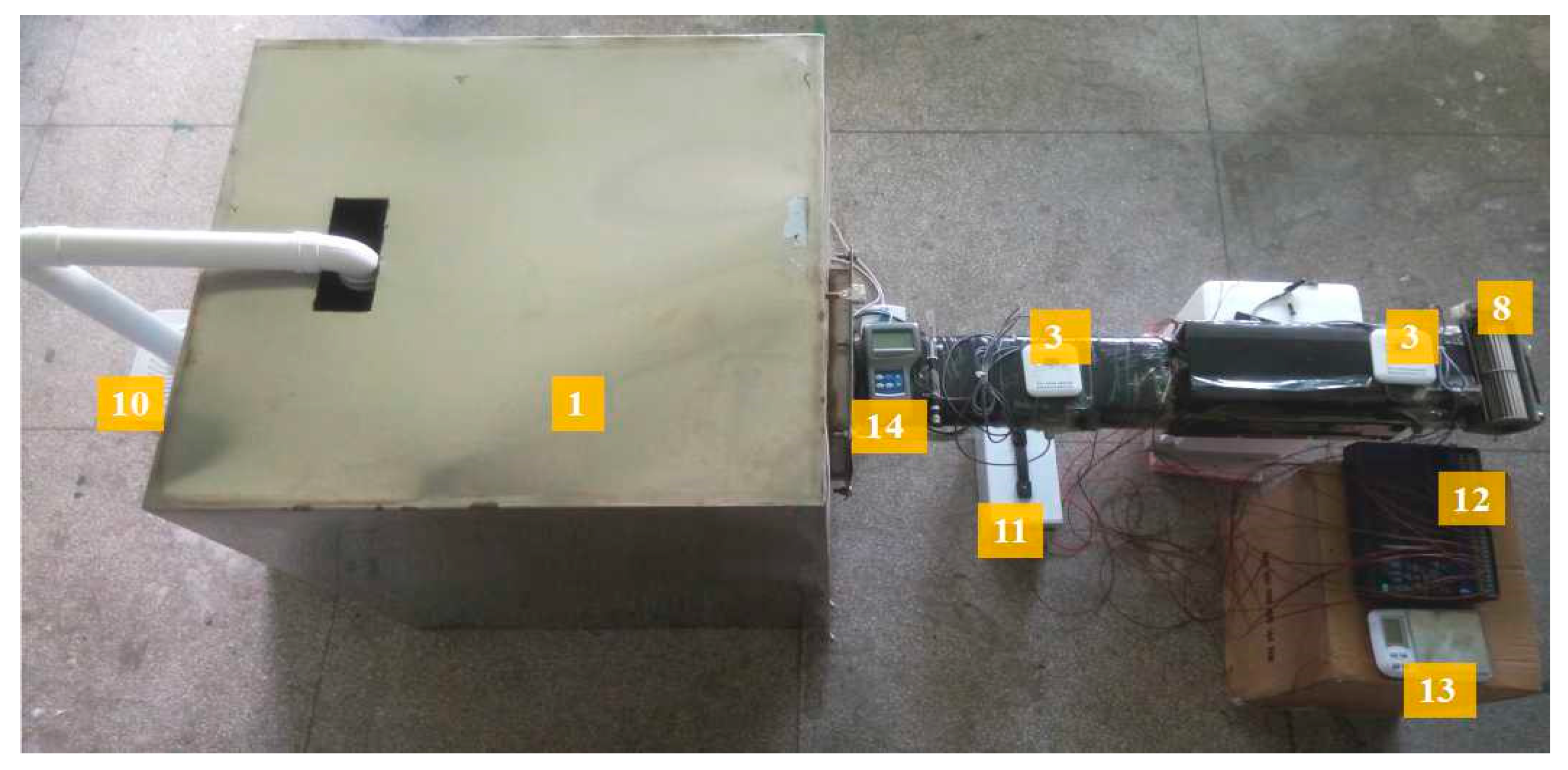
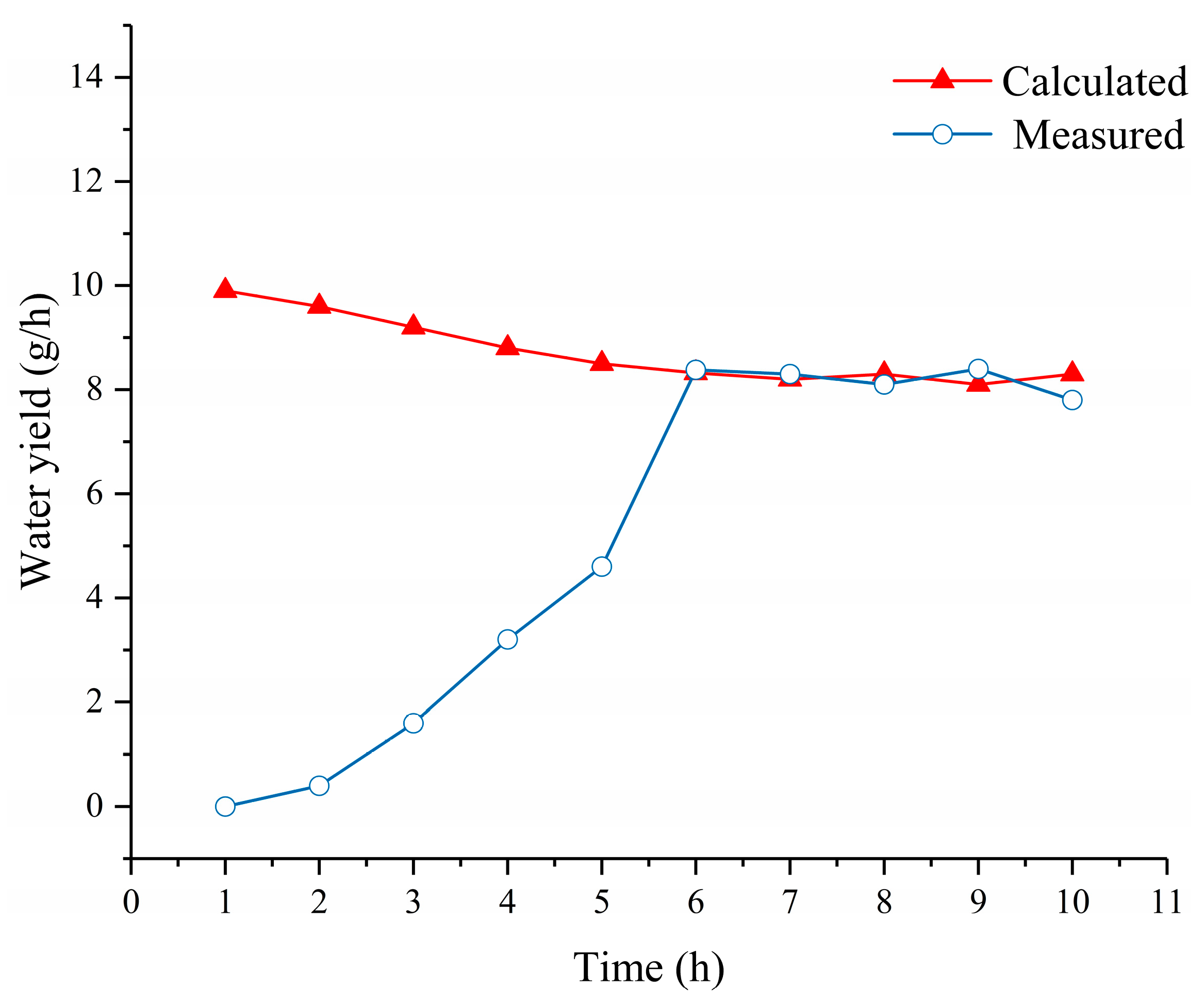
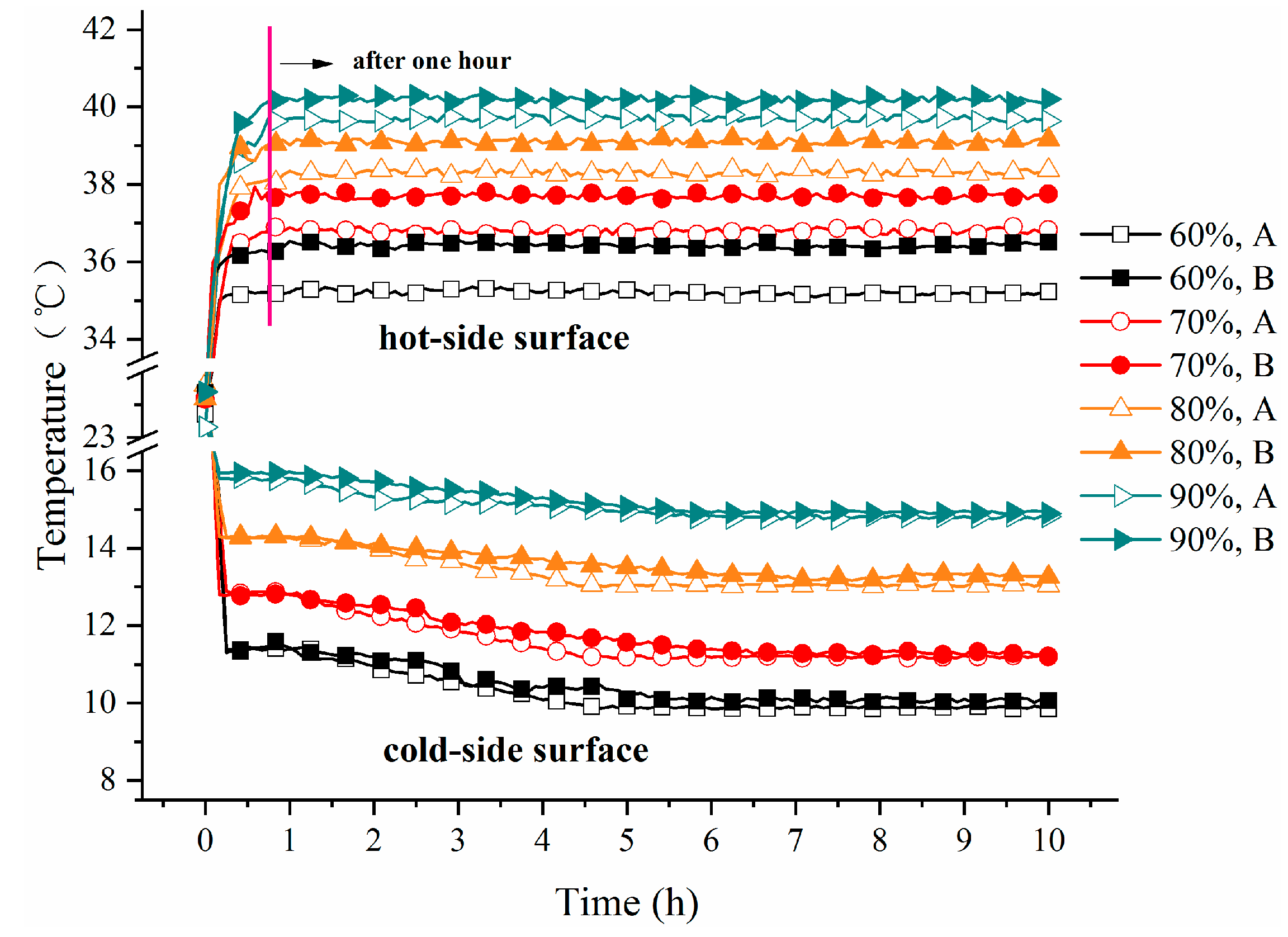
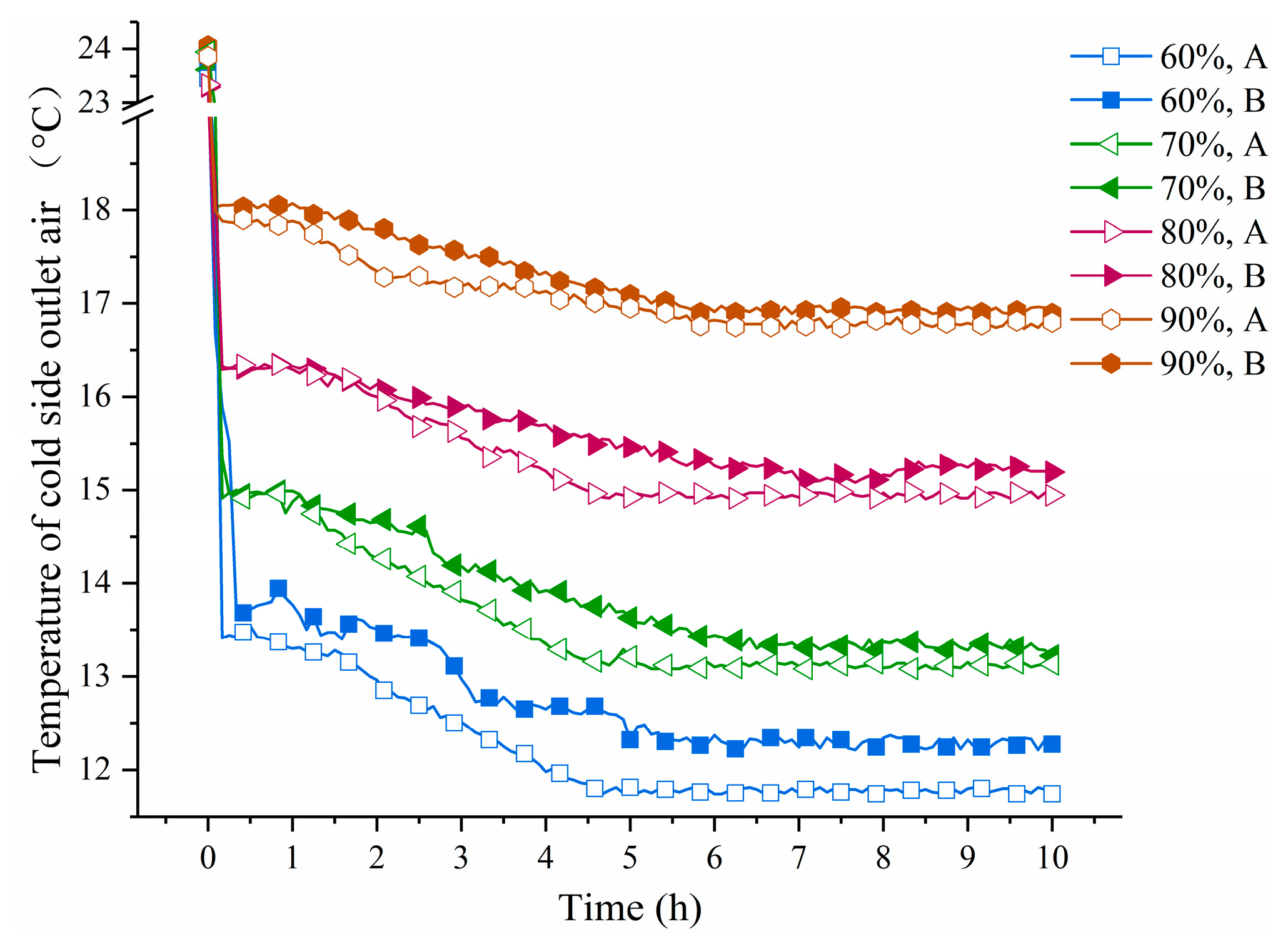
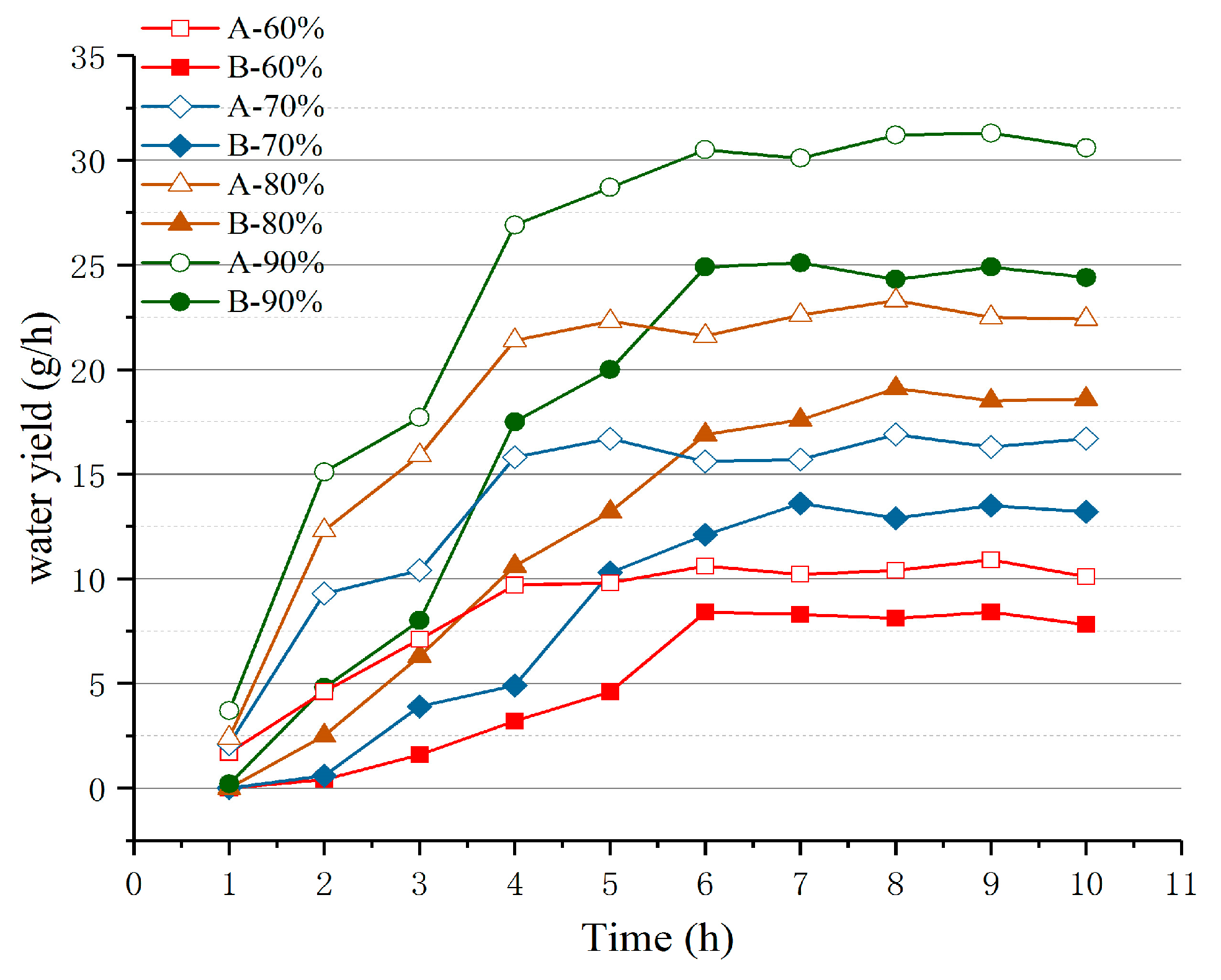
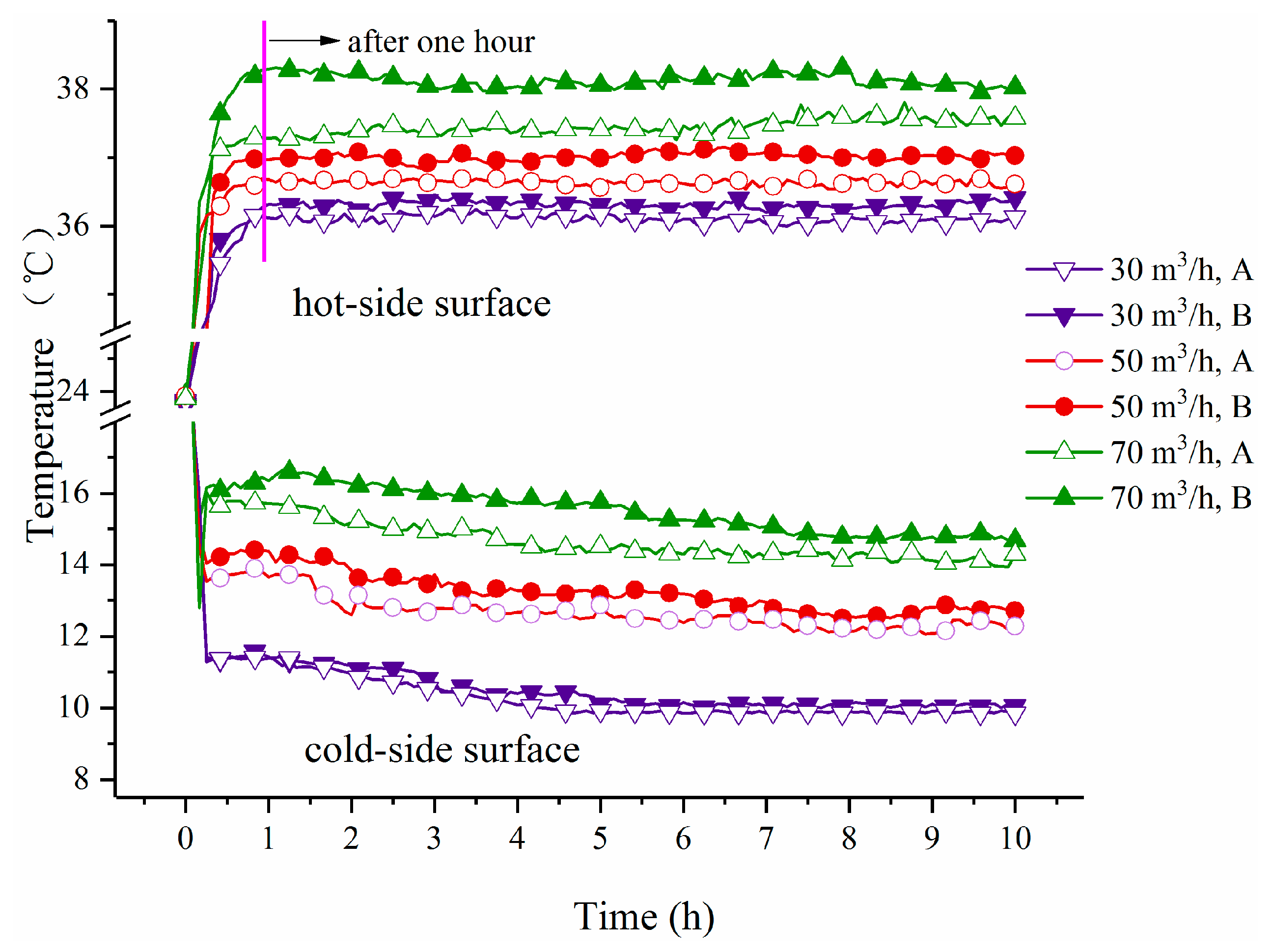


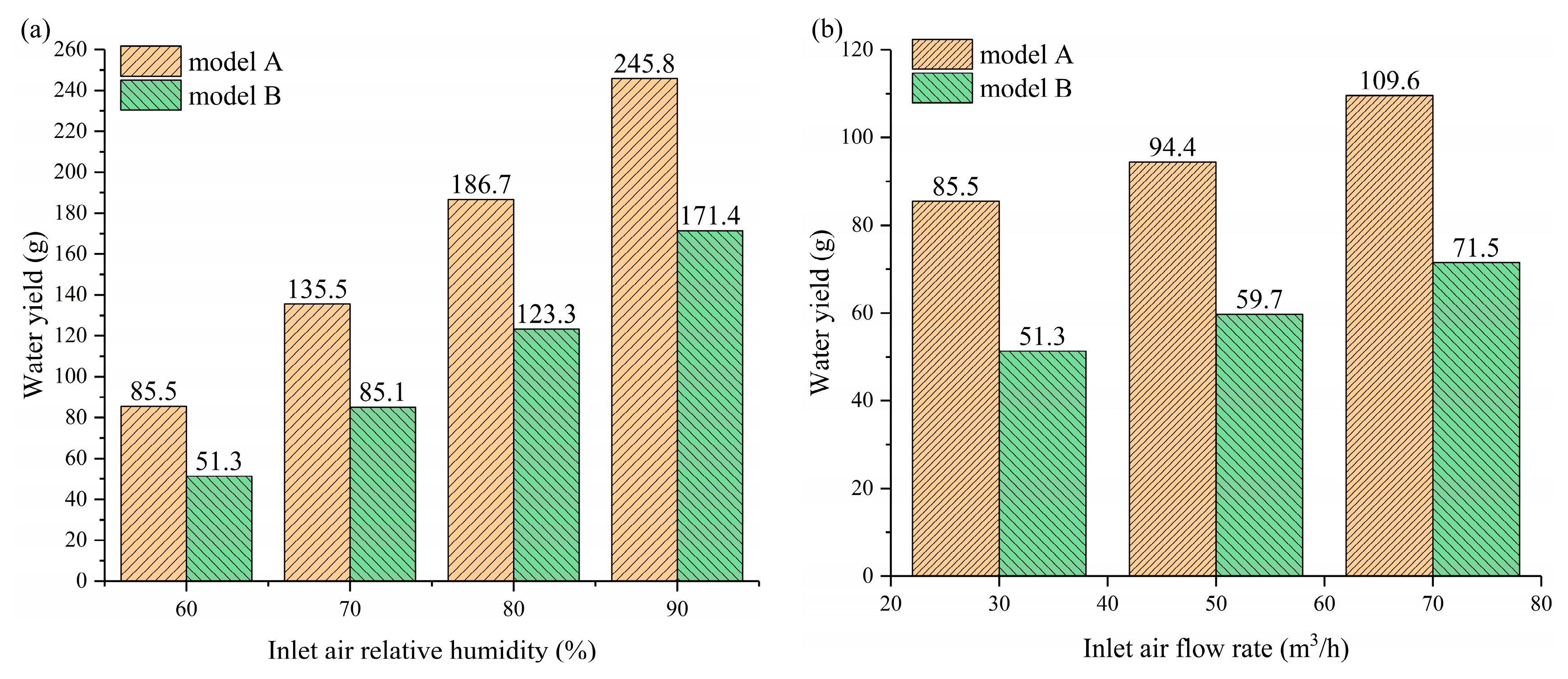
| System Components | Parameters |
|---|---|
| TEC module | |
| Numbers of P–N junctions n | 126 |
| Length (width), Ltec | 0.04 m |
| Thickness, Dtec | 0.004 m |
| Thermal slug | |
| Length of thermal slug, Lc | 0.18 m |
| Width of thermal slug, Wc | 0.1 m |
| Height of fins, Hc | 0.02 m |
| Distance of adjacent two fins, Dc | 0.002 m |
| Cross flow fans | |
| Maximum air flow rate, m | 250 m3/h |
| Air channel | |
| Length of air channel, La | 0.5 m |
| Cross sectional area of air channel, Aa | 5.6 × 10−3 m2 |
| Dimensions of mixing chamber | 0.8 m × 0.7 m × 1 m |
| Apparatuses | Unit | Range | Accuracy | Purpose |
|---|---|---|---|---|
| Thermocouple | °C | −180–260 | ±0.1 | Temperature testing |
| Anemometer | m/s | 5.00 | ±0.015 | Air flow rate testing |
| Hygrograph | % | 0~99.5 | ±3 | Air humidity testing |
| Electronic balance | g | 0~3000 | ±0.3 | Water generated testing |
| Cases | 1 | 2 | 3 | 4 | 5 | 6 |
|---|---|---|---|---|---|---|
| Air flow rate (m3/h) | 30 | 30 | 30 | 30 | 50 | 70 |
| Relative humidity (%) | 60 | 70 | 80 | 90 | 60 | 60 |
© 2019 by the authors. Licensee MDPI, Basel, Switzerland. This article is an open access article distributed under the terms and conditions of the Creative Commons Attribution (CC BY) license (http://creativecommons.org/licenses/by/4.0/).
Share and Cite
He, W.; Yu, P.; Hu, Z.; Lv, S.; Qin, M.; Yu, C. Experimental Study and Performance Analysis of a Portable Atmospheric Water Generator. Energies 2020, 13, 73. https://doi.org/10.3390/en13010073
He W, Yu P, Hu Z, Lv S, Qin M, Yu C. Experimental Study and Performance Analysis of a Portable Atmospheric Water Generator. Energies. 2020; 13(1):73. https://doi.org/10.3390/en13010073
Chicago/Turabian StyleHe, Wei, Pengkun Yu, Zhongting Hu, Song Lv, Minghui Qin, and Cairui Yu. 2020. "Experimental Study and Performance Analysis of a Portable Atmospheric Water Generator" Energies 13, no. 1: 73. https://doi.org/10.3390/en13010073
APA StyleHe, W., Yu, P., Hu, Z., Lv, S., Qin, M., & Yu, C. (2020). Experimental Study and Performance Analysis of a Portable Atmospheric Water Generator. Energies, 13(1), 73. https://doi.org/10.3390/en13010073





